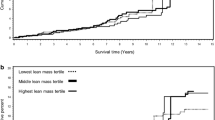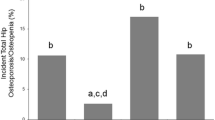Abstract
Background and aims
Loss of both muscle and bone mass results in fragility fractures with increased risk of disability, poor quality of life, and death. Our aim was to assess the association between low appendicular lean mass (aLM) defined according to different criteria and low bone mineral density (BMD) in hip-fracture women.
Methods
Six hundred fifty-three women admitted to our rehabilitation hospital underwent dual energy X-ray absorptiometry 19.1 ± 4.1 (mean ± SD) days after hip-fracture occurrence. Low aLM was identified according to either Baumgartner’s definition (aLM/height2 less than two standard deviations below the mean of the young reference group) or FNIH criteria: aLM <15.02 kg, or aLM adjusted for body mass index (BMI) <0.512. Low BMD was diagnosed with a T-score <−2.5 at the unfractured femoral neck.
Results
Using Baumgartner’s definition, the association between low aLM/height2 and low BMD was significant: χ 2(1, n = 653) = 8.52 (p = 0.004), but it was erased by adjustments for age and fat mass. Using the FNIH definition the association between low aLM and low BMD was significant: χ 2(1, n = 653) = 42.5 (p < 0.001), and it was confirmed after adjustment for age and fat mass (p < 0.001). With the FNIH definition based on aLM/BMI ratio the association between low aLM/BMI ratio and low BMD was nonsignificant: χ 2(1, n = 653) = 0.003 (p = 0.957).
Conclusions
The association between low aLM and low BMD in women with hip fracture dramatically depends on the adopted definition of low aLM. FNIH threshold for aLM (<15.02 kg) emerges as a useful tool to capture women with damage of the muscle-bone unit.

Similar content being viewed by others
References
Shimokata H, Ando F, Yuki A, Otsuka R (2014) Age-related changes in skeletal muscle mass among community-dwelling Japanese: a 12-year longitudinal study. Geriatr Gerontol Int 14(S1):85–92
Johnell O, Kanis JA, Oden A et al (2005) Predictive value of BMD for hip and other fractures. J Bone Miner Res 20:1185–1194
Kanis JA, McCloskey EV, Johansson H, Cooper C, Rizzoli R, Reginster JY, Scientific Advisory Board of the European Society for Clinical and Economic Aspects of Osteoporosis and Osteoarthritis (ESCEO) and the Committee of Scientific Advisors of the International Osteoporosis Foundation (IOF) (2013) European guidance for the diagnosis and management of osteoporosis in postmenopausal women. Osteoporos Int 24:23–57
Physician’s Guide to Prevention and Treatment of Osteoporosis. Washington, DC: The National Osteoporosis Foundation, 2013
Fielding RA, Vellas B, Evans WJ et al (2011) Sarcopenia: an undiagnosed condition in older adults. Current consensus definition: prevalence, etiology, and consequences. International working group on sarcopenia. J Am Med Dir Assoc 12:249–256
Muscaritoli M, Anker SD, Argilés J et al (2010) Consensus definition of sarcopenia, cachexia and pre-cachexia: joint document elaborated by Special Interest Groups (SIG) “cachexia-anorexia in chronic wasting diseases” and “nutrition in geriatrics”. Clin Nutr 29:154–159
Cruz-Jentoft AJ, Baeyens JP, Bauer JM et al; European Working Group on Sarcopenia in Older People (2010) Sarcopenia: European consensus on definition and diagnosis: Report of the European Working Group on Sarcopenia in Older People. Age Ageing 39: 412–423
Studenski SA, Peters KW, Alley DE et al (2014) The FNIH sarcopenia project: rationale, study description, conference recommendations, and final estimates. J Gerontol A Biol Sci Med Sci 69:547–558
Crepaldi G, Maggi S (2005) Sarcopenia and osteoporosis: a hazardous duet. J Endocrinol Invest 28(S10):66–68
He H, Liu Y, Tian Q, Papasian CJ, Hu T, Deng HW (2016) Relationship of sarcopenia and body composition with osteoporosis. Osteoporos Int 27:473–482
Sjoblom S, Suuronen J, Rikkonen T, Honkanen R, Kroger H, Sirola J (2013) Relationship between postmenopausal osteoporosis and the components of clinical sarcopenia. Maturitas 275:175–180
Verschueren S, Gielen E, O’Neill TW et al (2013) Sarcopenia and its relationship with bone mineral density in middle-aged and elderly European men. Osteoporos Int 24:87–98
Tarantino U, Baldi J, Celi M et al (2013) Osteoporosis and sarcopenia: the connections. Aging Clin Exp Res 25(S1):S93–S95
Girgis CM, Mokbel N, Digirolamo DJ (2014) Therapies for musculoskeletal disease: can we treat two birds with one stone? Curr Osteoporos Rep 12:142–153
Urano T, Inoue S (2015) Recent genetic discoveries in osteoporosis, sarcopenia and obesity. Endocr J 62:475–484
Tagliaferri C, Wittrant Y, Davicco MJ, Walrand S, Coxam V (2015) Muscle and bone, two interconnected tissues. Ageing Res Rev 21:55–70
Di Monaco M, Vallero F, Di Monaco R, Tappero R (2011) Prevalence of sarcopenia and its association with osteoporosis in 313 older women following a hip fracture. Arch Gerontol Geriatr 52:71–74
Di Monaco M, Castiglioni C, De Toma E et al (2015) Presarcopenia and sarcopenia in hip-fracture women: prevalence and association with ability to function in activities of daily living. Aging Clin Exp Res 27:465–472
Hida T, Ishiguro N, Shimokata H et al (2013) High prevalence of sarcopenia and reduced leg muscle mass in Japanese patients immediately after a hip fracture. Geriatr Gerontol Int 13:413–420
Baumgartner RN, Koehler KM, Gallagher D et al (1998) Epidemiology of sarcopenia among the elderly in New Mexico. Am J Epidemiol 147:755–763
Cawthon PM, Peters KW, Shardell MD et al (2014) Cutpoints for low appendicular lean mass that identify older adults with clinically significant weakness. J Gerontol A Biol Sci Med Sci 69:567–575
Drey M, Sieber CC, Bertsch T, Bauer JM, Schmidmaier R, FiAT intervention group (2016) Osteosarcopenia is more than sarcopenia and osteopenia alone. Aging Clin Exp Res doi:10.1007/s40520-015-0494-1
Cederholm T, Cruz-Jentoft AJ, Maggi S (2013) Sarcopenia and fragility fractures. Eur J Phys Rehabil Med 49:111–117
Fiatarone Singh MA, Singh NA, Hansen RD et al (2009) Methodology and baseline characteristics for the sarcopenia and hip fracture study: a 5-year prospective study. J Gerontol A Biol Sci Med Sci 64:568–574
González-Montalvo JI, Alarcon T, Gotor P et al (2015) Prevalence of sarcopenia in acute hip fracture patients and its influence on short-term clinical outcome. Geriatr Gerontol Int. doi:10.1111/ggi.12590
Sanada K, Miyachi M, Tanimoto M et al (2010) A cross-sectional study of sarcopenia in Japanese men and women: reference values and association with cardiovascular risk factors. Eur J Appl Physiol 110:57–65
Masanes F, Culla A, Navarro-Gonzalez M et al (2012) Prevalence of sarcopenia in healthy community-dwelling elderly in an urban area of Barcelona (Spain). J Nutr Health Aging 16:184–187
Castaneda C, Janssen I, Castaneda C, Janssen I (2005) Ethnic comparisons of sarcopenia and obesity in diabetes. Ethn Dis 15:664–670
D’Adamo CR, Hawkes WG, Miller RR et al (2014) Short-term changes in body composition after surgical repair of hip fracture. Age Ageing 43:275–280
Fox KM, Magaziner J, Hawkes WG et al (2000) Loss of bone density and lean body mass after hip fracture. Osteoporos Int 11:31–35
Di Monaco M, Castiglioni C (2016) Weakness and low lean mass in women with hip fracture: prevalence according to the FNIH criteria and association with the short-term functional recovery. J Geriatr Phys Ther. doi:10.1519/JPT.0000000000000075
McLean RR, Shardell MD, Alley DE et al (2014) Criteria for clinically relevant weakness and low lean mass and their longitudinal association with incident mobility impairment and mortality: the foundation for the National Institutes of Health (FNIH) sarcopenia project. J Gerontol A Biol Sci Med Sci 69:576–583
Di Monaco M, Castiglioni C, Di Monaco R, Tappero R (2015) Prevalence and burden of vertebral fractures in older men and women with hip fracture: a cross-sectional study. Geriatr Gerontol Int. doi:10.1111/ggi.12479
Ha YC, Baek JH, Ko YB, Park SM, Song SH (2015) High mortality and poor morbidity after hip fracture in patients with previous vertebral fractures. J Bone Miner Metab 33:547–552
Degens H, Korhonen MT (2012) Factors contributing to the variability in muscle ageing. Maturitas 73:197–201
Funding
This research did not receive any specific grant from funding agencies in the public, commercial, or not-for-profit sectors.
Author information
Authors and Affiliations
Corresponding author
Ethics declarations
Conflict of interest
On behalf of all the authors, the corresponding author states that there is no conflict of interest.
Ethical approval
All procedures performed in studies involving human participants were in accordance with the ethical standards of the institutional and/or national research committee and with the 1964 Helsinki declaration and its later amendments or comparable ethical standards.
Informed consent
Informed consent was obtained from all individual participants included in the study.
Rights and permissions
About this article
Cite this article
Di Monaco, M., Castiglioni, C., Di Monaco, R. et al. Association between low lean mass and low bone mineral density in 653 women with hip fracture: does the definition of low lean mass matter?. Aging Clin Exp Res 29, 1271–1276 (2017). https://doi.org/10.1007/s40520-017-0724-9
Received:
Accepted:
Published:
Issue Date:
DOI: https://doi.org/10.1007/s40520-017-0724-9




